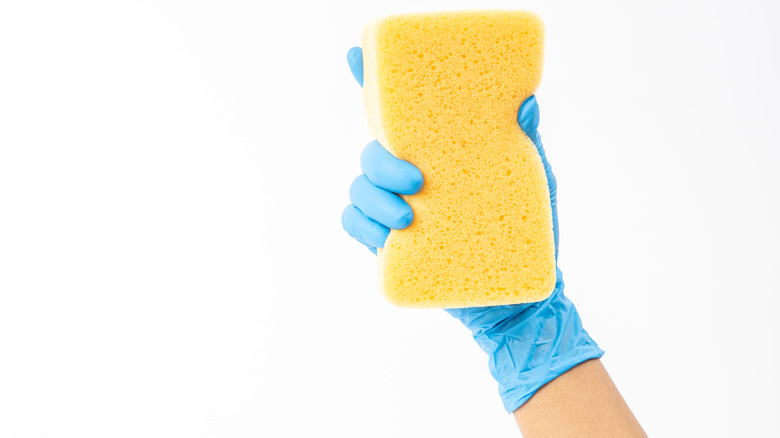A Dishwasher Is All You Need To Deep-Clean Your Kitchen Sponges
Kitchen sponges can be a helpful tool to clean anything from countertops to cookware. With that said, any damp environment can quickly become a breeding ground for bacteria, which means you need to be diligent about taking steps to avoid bacteria growth. When it comes to sanitizing your kitchen sponge, the dishwasher is the perfect place to turn. Thankfully, sponges are dishwasher safe, which keeps the process simple. Just load them into the top rack of the dishwasher along with your dirty cups, and let the hot water and detergent work its magic.
While the dishwasher is a great way to disinfect, that doesn't mean a kitchen sponge will last forever. There are easy ways to tell when it's time to replace yours (it's more often than you might (think), and if you don't have a dishwasher in your kitchen, there is also another method you can use to keep those sponges clean.
How to properly sanitize your kitchen sponge
If you have an extra hot heat setting on your dishwasher (it might be labeled "sanitize" or some other disinfectant term), then this is the best cycle for the sponge. Dishwashers' typical cycles heat to somewhere between 130 and 140 degrees, while a sanitize cycle can get up to 150 and also usually washes the dishes for longer. The latter is the best cycle to use to clean your kitchen sponges, but a regular cycle should work, too. And if you have the option, add a heat-dry cycle to the washing as well because it will continue to kill bacteria while helping to dry the sponge.
Although using the dishwasher will clean the sponge, that doesn't mean you should use the same sponge in perpetuity. It's best to wash your sponge every other day in order to prevent bacteria buildup, but if the sponge starts to look stained or smell bad, you should replace it. Even if it looks and smells fine, replace your sponge every two weeks, because bacteria can still start to build up over long periods of time.
Is dishwashing the only method for sanitizing your sponge?
Dishwashing is one of the easiest methods for getting your sponge clean, and it also kills almost all bacteria. With that said, not every kitchen is equipped with a dishwasher, so if you don't have one, you can still sanitize the sponge in other ways.
The microwave is another great option for cleaning your sponge. If the sponge is wet, the microwave will essentially steam it, raising the temperature enough to clean it; just wet the sponge entirely, then pop it in the microwave for 60 seconds. That said, microwaving a sponge may still leave behind some bacteria, which may do more harm than good. Also, never microwave a dry sponge because it's a fire hazard.
Another alternative is full-strength vinegar. This differs from white vinegar and is much stronger, so wear gloves when using this method — and don't consume the vinegar. Rinse the sponge well, then soak it in the vinegar for about five minutes. Wring it out, and you're good to go.


